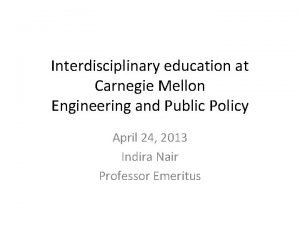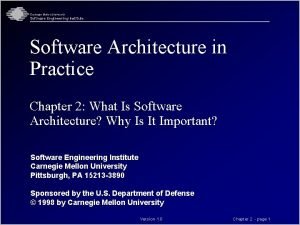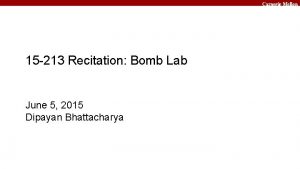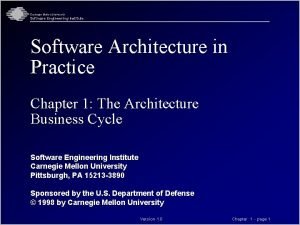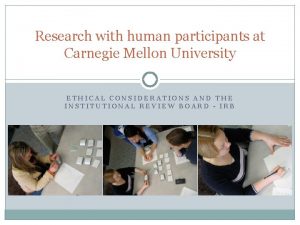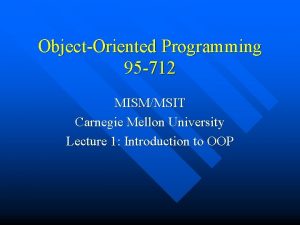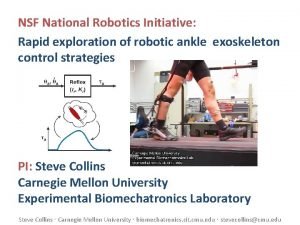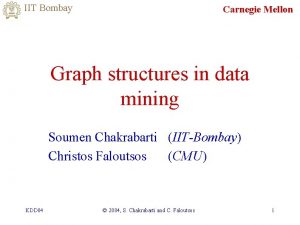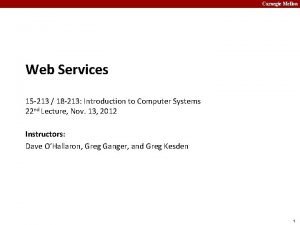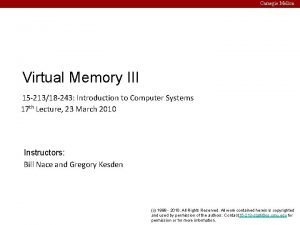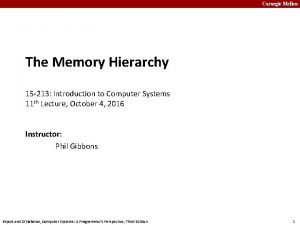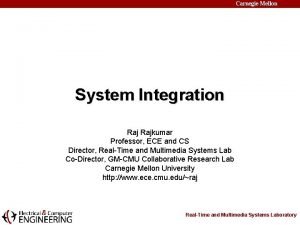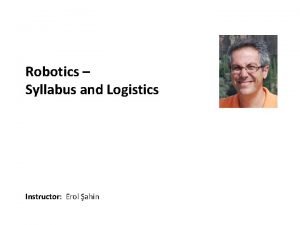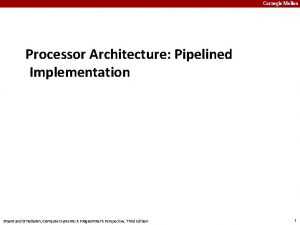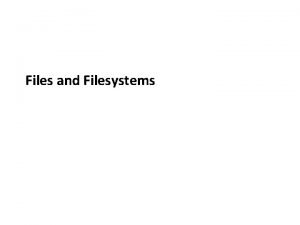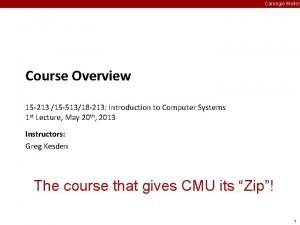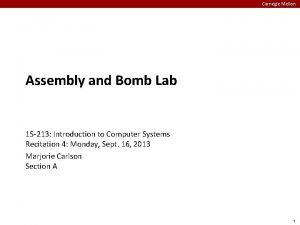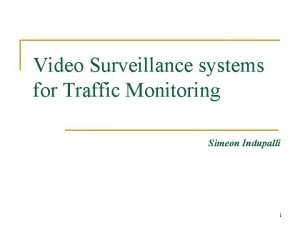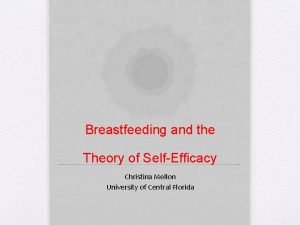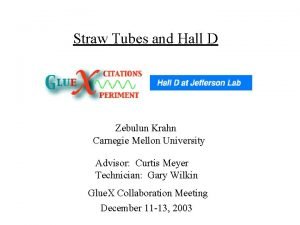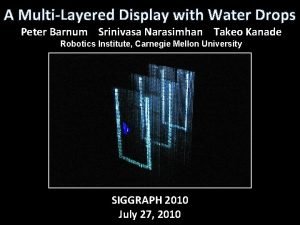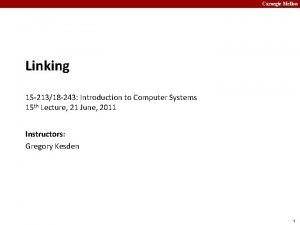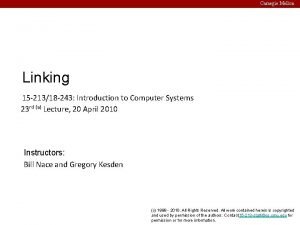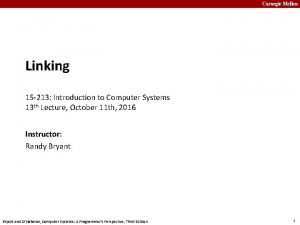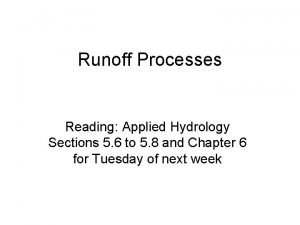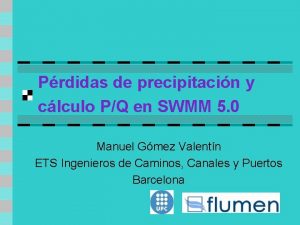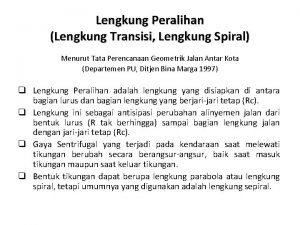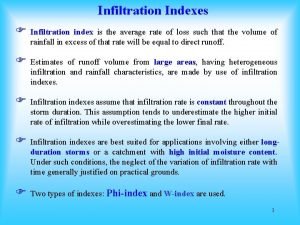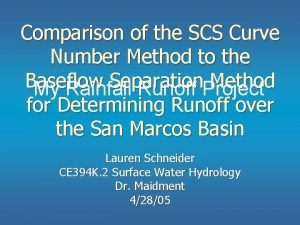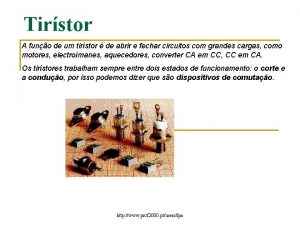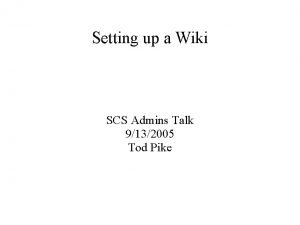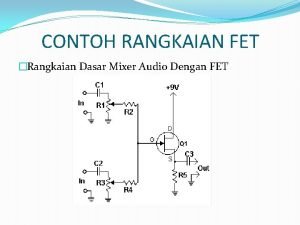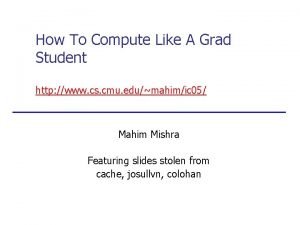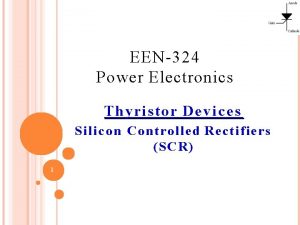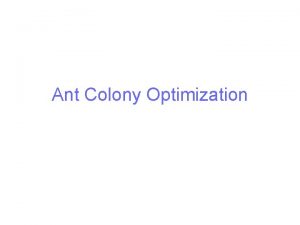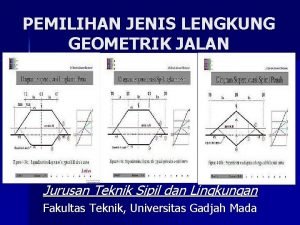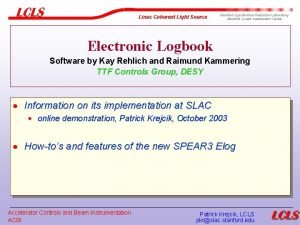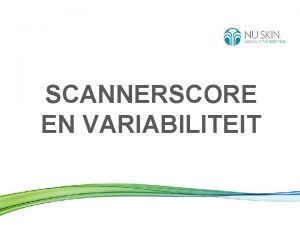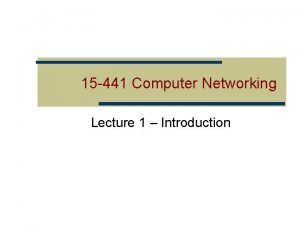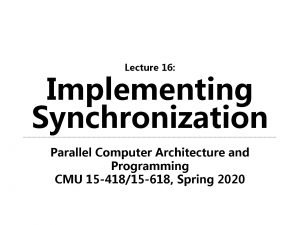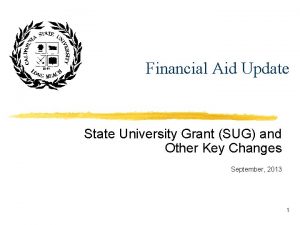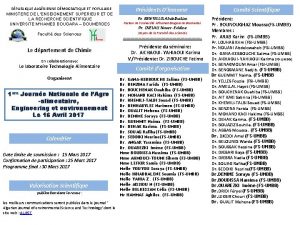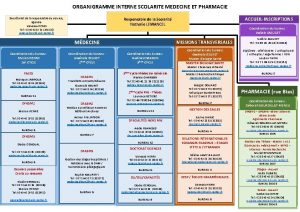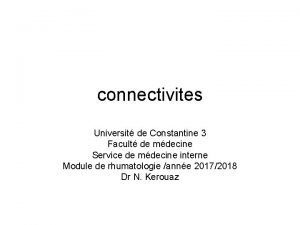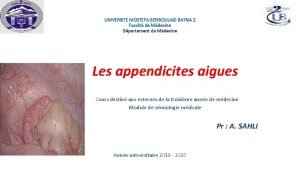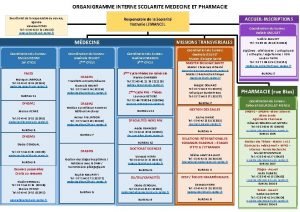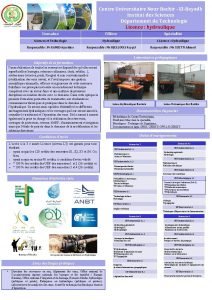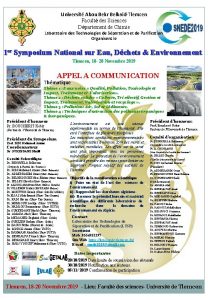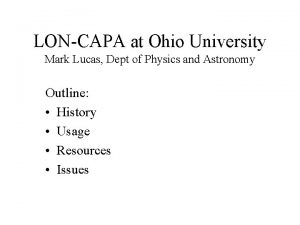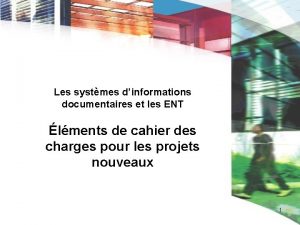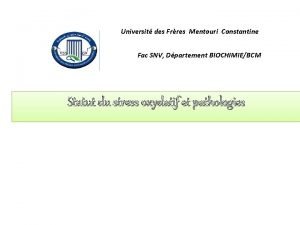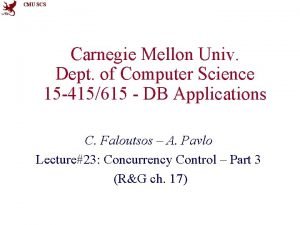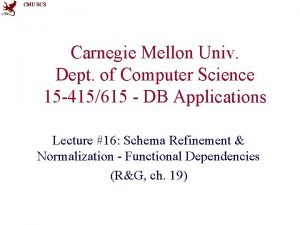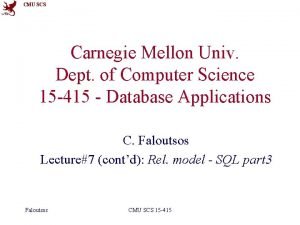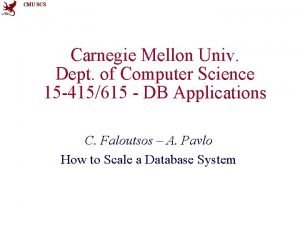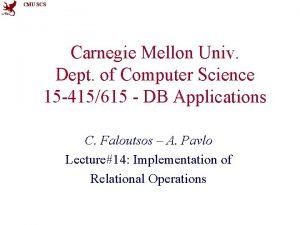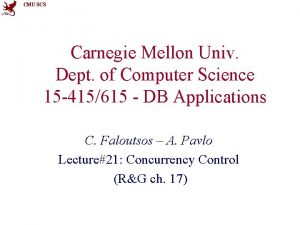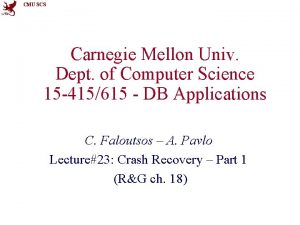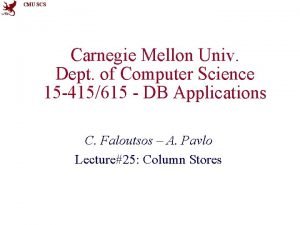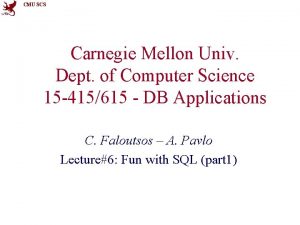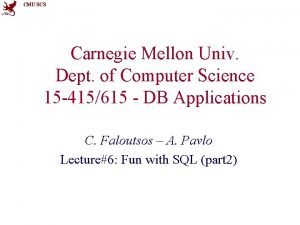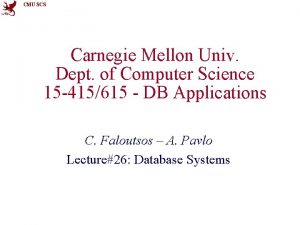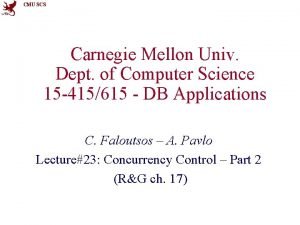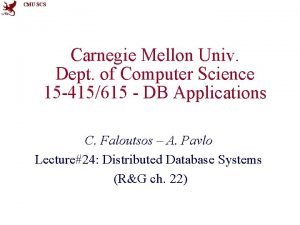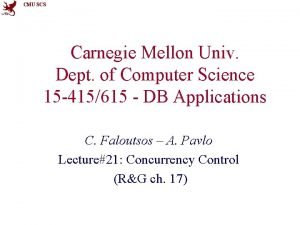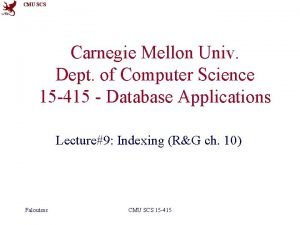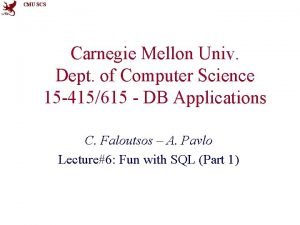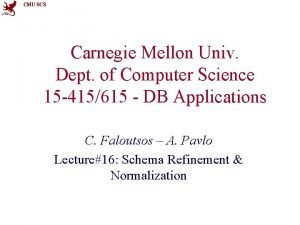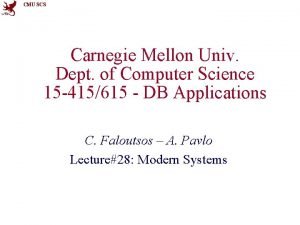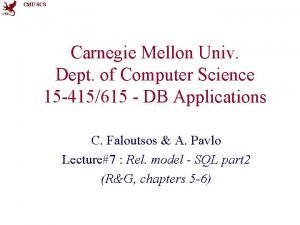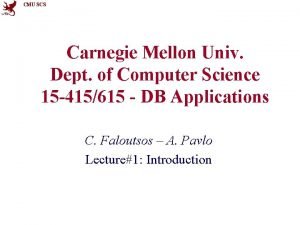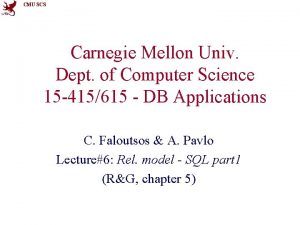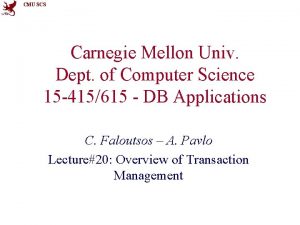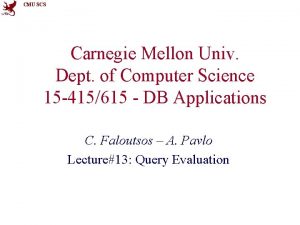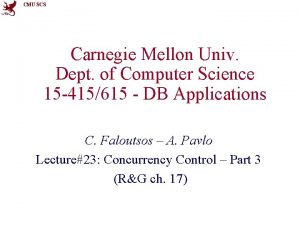CMU SCS Carnegie Mellon Univ Dept of Computer








































































- Slides: 72

CMU SCS Carnegie Mellon Univ. Dept. of Computer Science 15 -415/615 - DB Applications C. Faloutsos – A. Pavlo Lecture#23: Crash Recovery – Part 2 (R&G ch. 18)

CMU SCS Administrivia • HW 8 is due Thurs April 24 th Faloutsos/Pavlo CMU SCS 15 -415/615 2

CMU SCS Last Class • • Shadow Paging Write-Ahead Log Checkpoints Logging Schemes Faloutsos/Pavlo CMU SCS 15 -415/615 4

CMU SCS Crash Recovery • Recovery algorithms are techniques to ensure database consistency, transaction atomicity and durability despite failures. • Recovery algorithms have two parts: – Actions during normal txn processing to ensure that the DBMS can recover from a failure. – Actions after a failure to recover the database to a state that ensures atomicity, consistency, and durability. Faloutsos/Pavlo CMU SCS 15 -415/615 5

CMU SCS fsync(2) • Kernel maintains a buffer cache between applications & disks. – If you just call write(), there is no guarantee that the data is durable on disk. • Use fsync() to force the OS to flush all modified in-core data to disk. – This blocks the thread until it completes. – Data may still live in on-disk cache but we cannot control that. Faloutsos/Pavlo CMU SCS 15 -415/615 6

CMU SCS Buffer Pool – Steal Policy • Whether the DBMS allows an uncommitted txn to overwrite the most recent committed value of an object in non-volatile storage. – STEAL: Is allowed. – NO-STEAL: Is not allowed. Faloutsos/Pavlo CMU SCS 15 -415/615 7

CMU SCS Buffer Pool – Force Policy • Whether the DBMS ensures that all updates made by a txn are reflected on non-volatile storage before the txn is allowed to commit: – FORCE: Is enforced. – NO-FORCE: Is not enforced. Faloutsos/Pavlo CMU SCS 15 -415/615 8

CMU SCS Write-Ahead Logging WAL (Tail) WAL <T 5 begin> <T 5, A, 99, 88> <T 5, B, 5, 10> <T 5 commit> ⋮ Buffer Pool A=99 B=5 … … Database Volatile Storage Non-Volatile Storage

CMU SCS Writing Log Records • We don’t want to write one record at a time • How should we buffer them? – Batch log updates (group commit). • Page i can be written out only after the corresponding log record has been flushed. Faloutsos/Pavlo CMU SCS 15 -415/615 10

CMU SCS Memory Pinning • The DBMS needs to be able restrict when pages are flushed to disk. • “Pinning” a page means that the buffer pool manager is not allowed to flush that page. – Think of it like a lock. • NOTE: Block == Page – I use these terms interchangeably. – They mean the same thing. Faloutsos/Pavlo CMU SCS 15 -415/615 11

CMU SCS Memory Pinning • The DBMS un-pins a data page ONLY if all the corresponding log records that modified that page have been flushed to the log. Faloutsos/Pavlo CMU SCS 15 -415/615 12

CMU SCS Checkpoints WAL <T 1 begin> <T 1, A, 1, 2> <T 1 commit> <T 2 begin> <T 2, A, 2, 3> <T 3 begin> <CHECKPOINT> <T 2 commit> <T 3, A, 3, 4> ⋮ CRASH! Faloutsos/Pavlo • Any txn that committed before the checkpoint is ignored (T 1). • T 2 + T 3 did not commit before the last checkpoint. – Need to redo T 2 because it committed after checkpoint. – Need to undo T 3 because it did not commit before the crash. CMU SCS 15 -415/615 13

CMU SCS Summary • Write-Ahead Log to handle loss of volatile storage. • Use incremental updates (i. e. , STEAL, NOFORCE) with checkpoints. • On recovery, make sure that: – Committed txns are atomic + durable. – Uncommitted txns are removed. Faloutsos/Pavlo CMU SCS 15 -415/615 14

CMU SCS Today's Class – ARIES • Algorithms for Recovery and Isolation Exploiting Semantics – Write-ahead Logging – Repeating History during Redo – Logging Changes during Undo Faloutsos/Pavlo CMU SCS 15 -415/615 15

CMU SCS ARIES • Developed at IBM during the early 1990 s. • Considered the “gold standard” in database crash recovery. – Implemented in DB 2. – Everybody else more or less implements a variant of it. C. Mohan IBM Fellow Faloutsos/Pavlo CMU SCS 15 -415/615 16

CMU SCS ARIES – Main Ideas • Write-Ahead Logging: – Any change is recorded in log on stable storage before the database change is written to disk. • Repeating History During Redo: – On restart, retrace actions and restore database to exact state before crash. • Logging Changes During Undo: – Record undo actions to log to ensure action is not repeated in the event of repeated failures. Faloutsos/Pavlo CMU SCS 15 -415/615 18

CMU SCS ARIES – Main Ideas • Write Ahead Logging – Fast, during normal operation – Least interference with OS (i. e. , STEAL, NO FORCE) • Fast (fuzzy) checkpoints • On Recovery: – Redo everything. – Undo uncommitted txns. Faloutsos/Pavlo CMU SCS 15 -415/615 19

CMU SCS Today’s Class • • Log Sequence Numbers Normal Commit & Abort Operations Fuzzy Checkpointing Recovery Algorithm Faloutsos/Pavlo CMU SCS 15 -415/615 20

CMU SCS WAL Records • We’re going to extend our log record format from last class to include additional info. • Every log record has a globally unique log sequence number (LSN). • Q: Why do we need it? Faloutsos/Pavlo CMU SCS 15 -415/615 21

CMU SCS Log Sequence Number Name Where Definition LSN – Log sequence number flushed. LSN RAM Last LSN on log (disk). page. LSN @pagei Latest update to pagei rec. LSN @pagei Earliest update to pagei last. LSN Tj Latest action of Tj Master Record Disk Faloutsos/Pavlo LSN of latest checkpoint CMU SCS 15 -415/615 22

CMU SCS Writing Log Records • Each data page contains a page. LSN. – The LSN of the most recent update to that page. • System keeps track of flushed. LSN. – The max LSN flushed so far. • For a page i to be written, must flush log at least to the point where: – page. LSNi ≤ flushed. LSN Faloutsos/Pavlo CMU SCS 15 -415/615 23

CMU SCS Writing Log Records Log Sequence Numbers WAL (Tail) 017: <T 5 begin> 018: <T 5, A, 99, 88> 019: <T 5, B, 5, 10> 020: <T 5 commit> ⋮ Buffer Pool Log Sequence Numbers ? page. LSN rec. LSN A=99 B=5 C=12 Safe to unpin because flushed. LSN page. LSN ≤ flushed. LSN Volatile Storage WAL page. LSN rec. LSN A=99 B=5 C=12 Master Record Database Non-Volatile Storage

CMU SCS Writing Log Records WAL (Tail) 017: <T 5 begin> 018: <T 5, A, 99, 88> 019: <T 5, B, 5, 10> 020: <T 5 commit> ? ⋮ Buffer Pool page. LSN rec. LSN A=99 B=5 C=12 Not safe to flushed. LSN unpin because page. LSN > flushed. LSN Volatile Storage page. LSN rec. LSN A=99 B=5 C=12 Master Record Database Non-Volatile Storage

CMU SCS Writing Log Records • LSNs: Written for each log record. • page. LSN: Stored in each page in database. • flushed. LSN: In-Memory only. Faloutsos/Pavlo CMU SCS 15 -415/615 26

CMU SCS Today’s Class • • Log Sequence Numbers Normal Commit & Abort Operations Fuzzy Checkpointing Recovery Algorithm Faloutsos/Pavlo CMU SCS 15 -415/615 27

CMU SCS Normal Execution • Series of reads & writes, followed by commit or abort. We do extra stuff to deal with non-atomic writes (e. g. , My. SQL’s doublewrite). • Assumptions: – Disk writes are atomic. – Strict 2 PL. – STEAL + NO-FORCE buffer management, with Write-Ahead Logging. Faloutsos/Pavlo CMU SCS 15 -415/615 28

CMU SCS Transaction Commit • Write commit record to log. • All log records up to txn’s commit record are flushed to disk. – Note that log flushes are sequential, synchronous writes to disk. – Many log records per log page. • When the commit succeeds, write an TXNEND record to log. Faloutsos/Pavlo CMU SCS 15 -415/615 29

CMU SCS Transaction Commit – Example We can trim the in-memory log up to flushed. LSN WAL (Tail) 012: <T 4 begin> 013: <T 4, A, 99, 88> 014: <T 4, B, 5, 10> 015: <T 4 commit> ⋮ 016: <T 4 txn-end> Buffer Pool page. LSN rec. LSN A=99 B=5 C=12 flushed. LSN = 015 Volatile Storage page. LSN rec. LSN A=99 B=5 C=12 Master Record Database Non-Volatile Storage

CMU SCS Transaction Commit • Q: Why not flush the dirty pages too? • A: Speed! This is why we use NO-FORCE – Example: One txn changes 100 tuples… Faloutsos/Pavlo CMU SCS 15 -415/615 31

CMU SCS Transaction Abort • Aborting a txn is actually a special case of the ARIES undo operation applied to only one transaction. • Add another field to our log records: – prev. LSN: The previous LSN for the txn. – This maintains a linked-list for each txn that makes it easy to walk through its records. Faloutsos/Pavlo CMU SCS 15 -415/615 32

CMU SCS Transaction Abort – Example LSN | prev. LSN WAL (Tail) 011|nil: <T 4 begin> 012|011: <T 4, A, 99, 88> 013|012: <T 4, B, 5, 10> 014|015: <T 4 abort> ⋮ 015|014: <T 4 txn-end> Important: We need Buffer Pool to record what steps we took to undo the txn. page. LSN rec. LSN A=99 B=5 C=12 flushed. LSN page. LSN rec. LSN A=99 B=5 C=12 Master Record Database Volatile Storage Non-Volatile Storage

CMU SCS Compensation Log Records • A CLR describes the actions taken to undo the actions of a previous update record. – It has all the fields of an update log record plus the undo. Next pointer (i. e. , the next-to-beundone LSN). • CLRs are added to log like any other record. Faloutsos/Pavlo CMU SCS 15 -415/615 34

CMU SCS TIME Transaction Abort – CLR Example LSN prev. LSN Txn. Id Type Object Before After 001 nil T 1 BEGIN - - - 002 001 T 1 UPDATE A 30 40 002 T 1 ABORT - - ⋮ 011 Faloutsos/Pavlo - CMU SCS 15 -415/615 35

CMU SCS TIME Transaction Abort – CLR Example LSN prev. LSN Txn. Id Type Object Before After 001 nil T 1 BEGIN - - - 002 001 T 1 UPDATE A 30 40 002 T 1 ABORT - - - 011 T 1 CLR A 40 30 ⋮ 011 ⋮ 026 Faloutsos/Pavlo CMU SCS 15 -415/615 36

CMU SCS TIME Transaction Abort – CLR Example LSN prev. LSN Txn. Id Type Object Before After undo. Next 001 nil T 1 BEGIN - - 002 001 T 1 UPDATE A 30 40 - 002 T 1 ABORT - - 011 T 1 CLR A 40 30 001 ⋮ 011 ⋮ 026 The LSN of the next log record to be undone. Faloutsos/Pavlo CMU SCS 15 -415/615 37

CMU SCS Abort Algorithm • First, write an ABORT record on log • Play back updates, in reverse order: for each update – Write a CLR log record – Restore old value • At end, write an END log record • Notice: CLRs never need to be undone Faloutsos/Pavlo CMU SCS 15 -415/615 38

CMU SCS Today’s Class • • Log Sequence Numbers Normal Execution & Abort Operations Fuzzy Checkpointing Recovery Algorithm Faloutsos/Pavlo CMU SCS 15 -415/615 39

CMU SCS (Non-Fuzzy) Checkpoints • The DBMS halts everything when it takes a checkpoint to ensure a consistent snapshot: – Stop all transactions. – Flushes dirty pages on disk. • This is bad… Faloutsos/Pavlo CMU SCS 15 -415/615 40

CMU SCS Better Checkpoints • Allow txns to keep on running. • Record internal system state as of the beginning of the checkpoint. – Active Transaction Table (ATT) – Dirty Page Table (DPT) Faloutsos/Pavlo CMU SCS 15 -415/615 41

CMU SCS Active Transaction Table (ATT) • One entry per currently active txn. – txn. Id: Unique txn identifier. – status: The current “mode” of the txn. – last. LSN: Most recent LSN written by txn. • Entry removed when txn commits or aborts. • Status Codes: – R → Running – C → Committing – U → Candidate for Undo 42

CMU SCS Dirty Page Table (DPT) • One entry per dirty page currently in buffer pool. – rec. LSN: The LSN of the log record that first caused the page to be dirty. Faloutsos/Pavlo CMU SCS 15 -415/615 43

CMU SCS Better Checkpoints WAL <T 1 start>. . . <T 1 commit>. . . <T 2, C, 100, 120> <CHECKPOINT ATT={T 2}, DPT={P 10, P 12}> <T 3 start> <T 2 commit> <T 3, A, 200, 400> <CHECKPOINT ATT={T 3}, DPT={P 10, P 33}> <T 3, B, 10, 12> Faloutsos/Pavlo • At the first checkpoint, T 2 is still running and there are two dirty pages (i. e. , P 10, P 12). • At the second checkpoint, T 3 is active and there are two dirty pages (i. e. , P 10, P 33). CMU SCS 15 -415/615 44

CMU SCS Fuzzy Checkpoints • Specifically, write to log: – BEGIN-CHECKPOINT: Indicates start of checkpoint – END-CHECKPOINT: Contains ATT + DPT. • The “fuzzy” part is because: – Other txns continue to run; so these tables accurate only as of the time of the BEGIN-CHECKPOINT record. – No attempt to force dirty pages to disk; Faloutsos/Pavlo CMU SCS 15 -415/615 45

CMU SCS Fuzzy Checkpoints WAL <T 1 start>. . . <T 1 commit>. . . <T 2, C, 100, 120> <BEGIN-CHECKPOINT> <T 3 start> <END-CHECKPOINT ATT={T 2}, DPT={P 10, P 12}> <T 2 commit> <T 3, A, 200, 400> <BEGIN-CHECKPOINT> <T 3, B, 10, 12> <END-CHECKPOINT ATT={T 3}, DPT={P 10, P 33}> Faloutsos/Pavlo • The LSN of the BEGINCHECKPOINT record is written to the Master Record entry. • Any txn that starts after the checkpoint is excluded from the txn table listing. CMU SCS 15 -415/615 46

CMU SCS Fuzzy Checkpoints • Q: Why do we need store the LSN of most recent checkpoint record on disk in the Master Record? • A: So that we know where to start from on recovery. Faloutsos/Pavlo CMU SCS 15 -415/615 47

CMU SCS Big Picture ATT WAL (Tail) Txn. Id Status last. LSN T 5 R 011 - - - - - DPT Page. Id rec. LSN P 100 001 P 101 002 P 102 003 P 103 004 WAL <T 5 begin> <T 5, A, 99, 88> <T 5, B, 5, 10> <T 5 commit> ⋮ Buffer Pool page. LSN rec. LSN A=99 B=5 C=12 Master Record flushed. LSN Volatile Storage Database Non-Volatile Storage

CMU SCS Today’s Class • • Log Sequence Numbers Normal Execution & Abort Operations Fuzzy Checkpointing Recovery Algorithm Faloutsos/Pavlo CMU SCS 15 -415/615 49

CMU SCS ARIES – Recovery Phases • Analysis: Read the WAL to identify dirty pages in the buffer pool and active txns at the time of the crash. • Redo: Repeat all actions starting from an appropriate point in the log. • Undo: Reverse the actions of txns that did not commit before the crash. Faloutsos/Pavlo CMU SCS 15 -415/615 50

CMU SCS ARIES - Overview • Start from last checkpoint found via Master Record. • Three phases. – Analysis - Figure out which txns committed or failed since checkpoint. – Redo all actions (repeat history) – Undo effects of failed txns. Oldest log rec. of txn active at crash Smallest rec. LSN in dirty page table after Analysis Last checkpoint CRASH! A R U 51

CMU SCS Recovery – Analysis Phase • Re-establish knowledge of state at checkpoint. – Examine ATT and DPT stored in the checkpoint. Faloutsos/Pavlo CMU SCS 15 -415/615 52

CMU SCS Recovery – Analysis Phase • Scan log forward from checkpoint. • END record: Remove txn from ATT. • All other records: – Add txn to ATT with status ‘UNDO’ – Set last. LSN=LSN – On commit, change txn status to ‘COMMIT’. • For UPDATE records: – If page P not in DPT, add P to DPT, set its rec. LSN=LSN. Faloutsos/Pavlo CMU SCS 15 -415/615 53

CMU SCS Recovery – Analysis Phase • At end of the Analysis Phase: – ATT tells the DBMS which txns were active at time of crash. – DPT tells the DBMS which dirty pages might not have made it to disk. Faloutsos/Pavlo CMU SCS 15 -415/615 54

CMU SCS Analysis Phase Example WAL 010: <BEGIN-CHECKPOINT> ⋮ 020: <T 96, A→P 33, 10, 15> ⋮ 030: <END-CHECKPOINT ATT={T 96, T 97}, DPT={P 20, P 33}> ⋮ 040: <T 96 commit> ⋮ 050: <T 96 end> ⋮ CRASH! Faloutsos/Pavlo LSN ATT DPT 020 (T 96, U) (P 33) 030 (T 96, U), (T 97, U) (P 33), (P 20) 040 (T 96, C), (T 97, U) (P 33), (P 20) 050 (T 97, U) (P 33), (P 20) 010 (Txn. Id, Status) CMU SCS 15 -415/615 55

CMU SCS Recovery – Redo Phase • The goal is to repeat history to reconstruct state at the moment of the crash: – Reapply all updates (even aborted txns!) and redo CLRs. – We can try to avoid unnecessary reads/writes. Faloutsos/Pavlo CMU SCS 15 -415/615 56

CMU SCS Recovery – Redo Phase Why start here? All else has been flushed. • Scan forward from the log record containing smallest rec. LSN in DPT. • For each update log record or CLR with a given LSN, redo the action unless: – Affected page is not in the DPT, or – Affected page is in DPT but has rec. LSN>LSN, or – page. LSN (in DB) ≥ LSN Faloutsos/Pavlo CMU SCS 15 -415/615 57

CMU SCS Recovery – Redo Phase • To redo an action: – Reapply logged action. – Set page. LSN to LSN. – No additional logging, no forcing! • At the end of Redo Phase, write END log records for all txns with status ‘C’ and remove them from the ATT. Faloutsos/Pavlo CMU SCS 15 -415/615 58

CMU SCS Recovery – Undo Phase • Goal: Undo all txns that were active at the time of crash (‘loser txns’) • That is, all txns with ‘U’ status in the ATT after the Analysis phase • Process them in reverse LSN order using the last. LSN’s to speed up traversal. • Write a CLR for every modification. Faloutsos/Pavlo CMU SCS 15 -415/615 59

CMU SCS Recovery – Undo Phase • To. Undo={last. LSNs of ‘loser’ txns} • Repeat until To. Undo is empty: – Pop largest LSN from To. Undo. – If this LSN is a CLR and undo. Next == nil, then write an END record for this txn. – If this LSN is a CLR, and undo. Next != nil, then add undo. Next to To. Undo – Else this LSN is an update. Undo the update, write a CLR, add prev. LSN to To. Undo. Faloutsos/Pavlo CMU SCS 15 -415/615 60

CMU SCS Undo Phase Example LSN Suppose that after end of analysis phase we have the following ATT: LOG 00 05 10 20 Txn. Id Status last. LSN T 32 U T 41 U 30 40 prev. LSNs 45 50 60 Faloutsos/Pavlo CMU SCS 15 -415/615 61

CMU SCS Undo Phase Example LSN Suppose that after end of analysis phase we have the following ATT: LOG 00 05 10 20 Txn. Id Status last. LSN T 32 U T 41 U 30 40 45 undo in reverse LSN order 50 60 Faloutsos/Pavlo CMU SCS 15 -415/615 62

CMU SCS Full Example LSN ATT Txn. Id Status last. LSN - - - - - DPT Page. Id rec. LSN - - - flushed. LSN To. Undo LOG 00 begin_checkpoint 05 end_checkpoint 10 update: T 1 writes P 5 20 update T 2 writes P 3 30 T 1 abort 40 CLR: Undo T 1 LSN 10 45 T 1 End 50 update: T 3 writes P 1 60 update: T 2 writes P 5 prev. LSNs CRASH Volatile Storage Faloutsos/Pavlo CMU SCS 15 -415/615 63

CMU SCS Full Example LSN ATT Txn. Id Status last. LSN - - - - - 00, 05 Page. Id rec. LSN - - - update: T 1 writes P 5 20 update T 2 writes P 3 30 T 1 abort CLR: Undo T 1 LSN 10, T 1 End 50 update: T 3 writes P 1 60 update: T 2 writes P 5 CRASH, RESTART 70 flushed. LSN begin_checkpoint, end_checkpoint 10 40, 45 DPT LOG To. Undo 80, 85 CLR: Undo T 2 LSN 60 CLR: Undo T 3 LSN 50, T 3 end CRASH, RESTART Volatile Storage Faloutsos/Pavlo CMU SCS 15 -415/615 64

CMU SCS Full Example LSN ATT Txn. Id Status last. LSN - - - - - 00, 05 Page. Id rec. LSN - - - update: T 1 writes P 5 20 update T 2 writes P 3 30 T 1 abort undo. Next CLR: Undo T 1 LSN 10, T 1 End 50 update: T 3 writes P 1 60 update: T 2 writes P 5 CRASH, RESTART 70 flushed. LSN begin_checkpoint, end_checkpoint 10 40, 45 DPT LOG To. Undo 80, 85 CLR: Undo T 2 LSN 60 CLR: Undo T 3 LSN 50, T 3 end CRASH, RESTART Volatile Storage Faloutsos/Pavlo CMU SCS 15 -415/615 65

CMU SCS Full Example LSN ATT Txn. Id Status last. LSN - - - - - 00, 05 Page. Id rec. LSN - - - update: T 1 writes P 5 20 update T 2 writes P 3 30 T 1 abort undo. Next CLR: Undo T 1 LSN 10, T 1 End 50 update: T 3 writes P 1 60 update: T 2 writes P 5 CRASH, RESTART 70 flushed. LSN begin_checkpoint, end_checkpoint 10 40, 45 DPT LOG To. Undo 80, 85 Flush WAL to disk! CLR: Undo T 2 LSN 60 CLR: Undo T 3 LSN 50, T 3 end CRASH, RESTART Volatile Storage Faloutsos/Pavlo CMU SCS 15 -415/615 66

CMU SCS Crash During Restart! LSN 00, 05 X LOG begin_checkpoint, end_checkpoint 10 update: T 1 writes P 5 20 update T 2 writes P 3 30 T 1 abort 40, 45 undo. Next CLR: Undo T 1 LSN 10, T 1 End 50 update: T 3 writes P 1 60 update: T 2 writes P 5 CRASH, RESTART 70 80, 85 CLR: Undo T 2 LSN 60 CLR: Undo T 3 LSN 50, T 3 end CRASH, RESTART Volatile Storage Faloutsos/Pavlo CMU SCS 15 -415/615 67

CMU SCS Crash During Restart! LSN ATT Txn. Id Status last. LSN - - - - - 00, 05 Page. Id rec. LSN - - - update: T 1 writes P 5 20 update T 2 writes P 3 30 T 1 abort undo. Next CLR: Undo T 1 LSN 10, T 1 End 50 update: T 3 writes P 1 60 update: T 2 writes P 5 CRASH, RESTART 70 flushed. LSN begin_checkpoint, end_checkpoint 10 40, 45 DPT LOG To. Undo 80, 85 CLR: Undo T 2 LSN 60 CLR: Undo T 3 LSN 50, T 3 end CRASH, RESTART Volatile Storage Faloutsos/Pavlo CMU SCS 15 -415/615 68

CMU SCS Crash During Restart! LSN ATT Txn. Id Status last. LSN - - - - - 00, 05 Page. Id rec. LSN - - - update: T 1 writes P 5 20 update T 2 writes P 3 30 T 1 abort undo. Next CLR: Undo T 1 LSN 10, T 1 End 50 update: T 3 writes P 1 60 update: T 2 writes P 5 CRASH, RESTART 70 flushed. LSN begin_checkpoint, end_checkpoint 10 40, 45 DPT LOG To. Undo 80, 85 CLR: Undo T 2 LSN 60 CLR: Undo T 3 LSN 50, T 3 end CRASH, RESTART Volatile Storage Faloutsos/Pavlo 90, 95 CLR: Undo T 2 LSN 20, T 2 end CMU SCS 15 -415/615 69

CMU SCS Additional Crash Issues • What happens if system crashes during the Analysis Phase? During the Redo Phase? • How do you limit the amount of work in the Redo Phase? – Flush asynchronously in the background. • How do you limit the amount of work in the Undo Phase? – Avoid long-running txns. Faloutsos/Pavlo CMU SCS 15 -415/615 70

CMU SCS Summary • ARIES - main ideas: – WAL (write ahead log), STEAL/NO-FORCE – Fuzzy Checkpoints (snapshot of dirty page ids) – Redo everything since the earliest dirty page; undo ‘loser’ transactions – Write CLRs when undoing, to survive failures during restarts Faloutsos/Pavlo CMU SCS 15 -415/615 71

CMU SCS ARIES – Recovery Phases • Analysis: Read the WAL to identify dirty pages in the buffer pool and active txns at the time of the crash. • Redo: Repeat all actions starting from an appropriate point in the log. • Undo: Reverse the actions of txns that did not commit before the crash. Faloutsos/Pavlo CMU SCS 15 -415/615 72

CMU SCS Summary • Additional concepts: – LSNs identify log records; linked into backwards chains per transaction (via prev. LSN). – page. LSN allows comparison of data page and log records. – And several other subtle concepts: undo. Next, rec. LSN, etc) Faloutsos/Pavlo CMU SCS 15 -415/615 73

CMU SCS Conclusion • Recovery is really hard. • Be thankful that you don’t have to write it yourself. Faloutsos/Pavlo CMU SCS 15 -415/615 74
 Comp bio cmu
Comp bio cmu Carnegie mellon interdisciplinary
Carnegie mellon interdisciplinary Carnegie mellon software architecture
Carnegie mellon software architecture Bomb threat carnegie mellon
Bomb threat carnegie mellon Carnegie mellon software architecture
Carnegie mellon software architecture Citi training cmu
Citi training cmu Cmu mism
Cmu mism Randy pausch time management
Randy pausch time management Carnegie mellon what is rpa robotic process automation
Carnegie mellon what is rpa robotic process automation Carnegie mellon
Carnegie mellon 18-213 cmu
18-213 cmu Carnegie mellon vpn
Carnegie mellon vpn Carnegie mellon
Carnegie mellon Carnegie mellon
Carnegie mellon Carnegie mellon
Carnegie mellon Frax
Frax Carnegie mellon fat letter
Carnegie mellon fat letter Cmu 15-513
Cmu 15-513 Cmu bomb lab
Cmu bomb lab Mellon serbia iskustva
Mellon serbia iskustva Carneigh mellon
Carneigh mellon Conclusion of breastfeeding
Conclusion of breastfeeding Wageworks health equity
Wageworks health equity Zebulun krahn
Zebulun krahn Water mellon
Water mellon Mellon elf
Mellon elf Mellon elf
Mellon elf Mellon elf
Mellon elf Desco industries rochester nh
Desco industries rochester nh Scs method
Scs method Lluvia neta
Lluvia neta Spiral circle spiral
Spiral circle spiral Infiltration index
Infiltration index Dioda diac
Dioda diac Scs curve number
Scs curve number Scs tiristor
Scs tiristor Wiki.scs
Wiki.scs Scs.ryerson.ca harley
Scs.ryerson.ca harley Simbol scs
Simbol scs Scs reasonable person principle
Scs reasonable person principle Scs thyristor
Scs thyristor Scs carleton
Scs carleton Scs archiver
Scs archiver Lengkung peralihan
Lengkung peralihan Scs elogs
Scs elogs Scs lulu
Scs lulu Scs methode
Scs methode Doc scs
Doc scs Skin carotenoid scanner
Skin carotenoid scanner 15441 cmu
15441 cmu Triangulation
Triangulation Synchronization in computer architecture
Synchronization in computer architecture Ut arlington demographics
Ut arlington demographics Université 3 constantine medecine
Université 3 constantine medecine Http:fsi-st univ-boumerdes-dz
Http:fsi-st univ-boumerdes-dz State univ grant - sug ug
State univ grant - sug ug Umbb inim
Umbb inim Scolarité univ nantes
Scolarité univ nantes Fs univ umbb
Fs univ umbb Univ constantine 3
Univ constantine 3 Pharmacie.univ-batna2
Pharmacie.univ-batna2 Scolarité médecine nantes
Scolarité médecine nantes Centre universitaire nour bachir el-bayadh
Centre universitaire nour bachir el-bayadh Prodoc univ nantes
Prodoc univ nantes Univ prof titel
Univ prof titel Univ tln moodle
Univ tln moodle Dr abou bekr
Dr abou bekr Licence spi poitiers
Licence spi poitiers (univ. caxias do sul) escolha a alternativa que completa
(univ. caxias do sul) escolha a alternativa que completa Ohio university lon capa
Ohio university lon capa Univ valenciennes ent
Univ valenciennes ent Ent université tours
Ent université tours Snv constantine
Snv constantine

